Week 1: August 1-7, 2005
|
|
| THIS WEEK | FALL TOTAL | YEAR TOTAL | SITE TOTAL | |
|---|---|---|---|---|
| # birds (and species) banded | 70 (22) | 70 (22) | 803 (66) | 1724 (80) |
| # birds (and species) repeat | 2 (2) | 2 (2) | 247 (18) | 425 (28) |
| # birds (and species) return | — | — | 29 (6) | 31 (7) |
| # species observed | 74 | 74 | 142 | 157 |
| # net hours | 71.5 | 71.5 | 1726.4 | 2700.9 |
| # birds banded / net hour | 97.9 | 97.9 | 46.6 | 63.8 |
Note: table does not include nocturnal banding (owls).
Bander-in-charge: Marcel Gahbauer Assistants: Helen Garland, Gay Gruner, Marie-Anne Hudson, Betsy McFarlane, Chris Murphy
Notes: At first it felt strange to declare the fall season underway on August 1, but over the past week we have found plenty of evidence that migration has indeed begun. While the greatest number of species seen on any day this week was 42, a total of 74 were seen, with many of them just passing through on one or two mornings. This is already more species than were seen in all of July!
One of the most noticeable migrations this week was that of the Yellow Warblers, which peaked on Wednesday morning with roughly 30 in the area. Also noteworthy were the flocks of juvenile Baltimore Orioles, sometimes 6-8 of them sharing the same branch of a large tree. Though most were present in small numbers, it was equally impressive to have 13 species of warbler present on August 6. With the addition of three others the next morning, we ended up with 16 warbler species for the week, including MBO’s first ever Bay-breasted.
The banding season got off to a great start with 21 birds in a single hour on August 1. Subsequent efforts on August 3 and 6 produced somewhat more modest numbers, but all the same we’re very happy to have already banded 69 birds in our first week, at a rate of nearly 100 birds per 100 net hours (double our spring average).
KEY TO TOP PHOTO: Top row (left to right): Nashville Warbler (juv), Common Yellowthroat (AHY male), Yellow Warbler (AHY female), Black-throated Green Warbler (AHY male) Middle row (left to right): Tennessee Warbler (HY unknown sex), Black-and-white Warbler (AHY female), Northern Waterthrush (AHY unknown sex), Black-throated Blue Warbler (HY female) Bottom row (left to right): Wilson’s Warbler (HY male), American Redstart (AHY female), Swamp Sparrow (HY unknown sex), Ovenbird (juv)
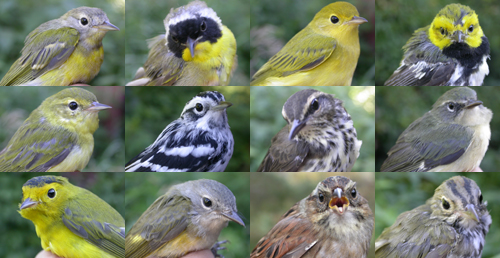
Week 2: August 8-14, 2005
|
|
| THIS WEEK | FALL TOTAL | YEAR TOTAL | SITE TOTAL | |
|---|---|---|---|---|
| # birds (and species) banded | 159 (28) | 229 (32) | 962 (72) | 1883 (83) |
| # birds (and species) repeat | 21 (12) | 23 (12) | 268 (21) | 446 (31) |
| # birds (and species) return | 2 (2) | 2 (2) | 31 (6) | 33 (7) |
| # species observed | 75 | 88 | 142 | 159 |
| # net hours | 128.75 | 200.25 | 1855.1 | 2829.6 |
| # birds banded / net hour | 123.5 | 114.4 | 52.0 | 66.5 |
Note: table does not include nocturnal banding (owls).
Bander-in-charge: Marcel Gahbauer Assistants: Jean Demers, Barbara Frei, Chris Gibb, Gay Gruner, Marie-Anne Hudson, Barbara MacDuff, Betsy McFarlane, Chris Murphy, Julie Pepin, Clemence Soulard, Alain Theriault
Notes: If we had any lingering doubts at all about migration being underway, they were erased this week. The 156 birds banded were nearly as many as in our peak week this spring, but in just half as many net hours!
For bird highlights this week, it’s difficult to know where to begin. Our site checklist rose by two species to 159, with the addition of Canada Warbler on Friday and Olive-sided Flycatcher on Saturday – two birds we had expected for a long time, but never found until now. For the year, we also added Red-breasted Nuthatch. Our list of species banded also increased nicely this week, with Eastern Wood-Pewee, Mourning Warbler, and the aforementioned Canada Warbler joining it.
Several species were much more common in the nets this week than ever before. Until now we had banded only 4 Indigo Buntings … this week alone we had 13! Similarly our Nashville Warbler jumped from a previous total of 10 to 28, and we doubled our cumulative count of Great-crested Flycatchers from 3 to 6. Worthy of honourable mention are the Rose-breasted Grosbeaks, with a single-day record of 6 on Saturday, for a total of 27 this year. The most common species of the week, however, was Yellow Warbler, with 19 banded and a few males from spring recaptured.
Also this week we hosted two groups of visitors. On Friday, we had three ‘ringers’ (aka banders) from Finland and Latvia join us for the morning. We greatly enjoyed the opportunity to exchange information about banding techniques, and the different (and in some cases same) species we encounter. On Saturday we had a group from Bird Protection Quebec spend the morning with us, and they made their mark by finding our first Olive-sided Flycatcher, as well as the first Purple Finch of the fall season.
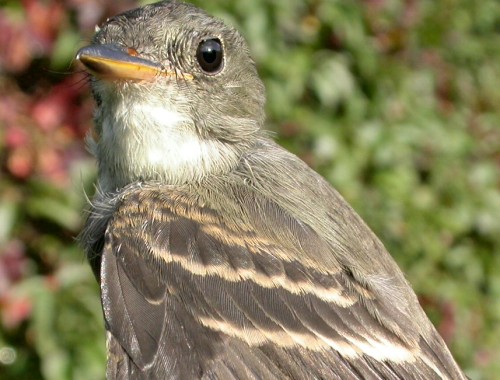 Although they breed in the woods at MBO, we had until this week never banded an Eastern Wood-Pewee. The photo above shows the buff wing bars typical of a hatch-year pewee, and it is very likely that this is one of the local birds. (Photo by Marcel Gahbauer)
Although they breed in the woods at MBO, we had until this week never banded an Eastern Wood-Pewee. The photo above shows the buff wing bars typical of a hatch-year pewee, and it is very likely that this is one of the local birds. (Photo by Marcel Gahbauer)
Week 3: August 15-21, 2005
|
|
| THIS WEEK | FALL TOTAL | YEAR TOTAL | SITE TOTAL | |
|---|---|---|---|---|
| # birds (and species) banded | 140 (38) | 369 (43) | 1102 (74) | 2023 (85) |
| # birds (and species) repeat | 26 (11) | 49 (13) | 294 (23) | 472 (33) |
| # birds (and species) return | 3 (3) | 5 (4) | 36 (8) | 36 (9) |
| # species observed | 67 | 93 | 143 | 160 |
| # net hours | 152.75 | 353 | 2007.8 | 2982.3 |
| # birds banded / net hour | 91.7 | 104.5 | 55.0 | 67.8 |
Note: table does not include nocturnal banding (owls).
Bander-in-charge: Marcel Gahbauer Assistants: Pierre Bannon, Gail Desnoyers, Barbara Frei, Gay Gruner, Marie-Anne Hudson, Barbara MacDuff, Betsy McFarlane, Chris Murphy, Alain Theriault
Notes: Another great August week! Despite only three days of banding this week, we had another 140 new birds, representing a surprisingly diverse list of 38 species. Among these was another first for MBO, a Cape May Warbler. One of last week’s new arrivals, Canada Warbler, showed up in force on Wednesday, with four of them being caught in rapid succession. Overall though, the most common warblers for the week remained Yellow, Nashville, Tennessee, and American Redstart.
Noticeable this week was a definite influx of flycatchers, as reflected in our photo quiz this week. Our local Eastern Phoebes appear to have abandoned us, and migrants have yet to arrive, but we managed to get to six flycatcher species banded despite their absence. We were particularly pleased to get an Eastern Kingbird on Friday – they had been around in good numbers all week long, but showed a remarkable ability to avoid the nets. It’s hard to miss their presence though – chasing each other, robins, jays, sharp-shinned hawks … and getting chased on at least two occasions by Ruby-throated Hummingbirds!
Both on Monday and Wednesday we had over 50 birds banded, but otherwise the mornings were quite different. On Monday we shattered our previous record for species banded in a day with 28 (previously 23), and added another 4 species through recaptures. It was also a somewhat painful day for us, as the birds captured included 6 woodpeckers, 4 Rose-breasted Grosbeaks, 3 Chickadees, and a viciously knuckle-pecking Baltimore Oriole. Wednesday we were back down to 22 species, nearly half of which were very nicely behaved warblers.
New arrivals this week included a remarkably early Ruby-crowned Kinglet, a somewhat early Swainson’s Thrush, and unexpected sightings of Northern Harrier and Wilson’s Snipe. Other birds are hanging around for a while – we have at least two Tennessee Warblers that have lingered a week or longer, and have also recaptured Black-throated Blue Warbler and Black-and-white Warbler after a period of several days. However, the weather for the coming week is significantly cooler than it has been, so we are likely to see quite a turnover in the birds at MBO.
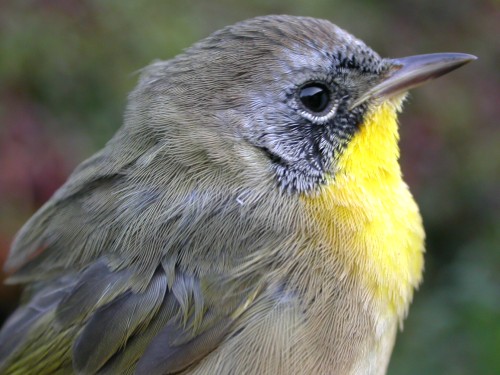 Another milestone passed – this hatch-year male Common Yellowthroat was the 2000th bird banded at MBO, early in the morning on Friday August 19. (Photo by Marcel Gahbauer)
Another milestone passed – this hatch-year male Common Yellowthroat was the 2000th bird banded at MBO, early in the morning on Friday August 19. (Photo by Marcel Gahbauer)
KEY TO TOP PHOTO: Top row (left to right): Least Flycatcher (note the distinct eye ring) Traill’s Flycatcher (after-hatch-year by white wing bars) Yellow-bellied Flycatcher (lack of contrast between upper and lower parts) Bottom row (left to right): Eastern Wood-Pewee (dusky lower mandible; hatch-year by buff wing bars) Black-throated Blue Warbler (note the white patch on the primaries; juvenile) Eastern Kingbird (after-hatch-year male, though age/sex not evident from this photo)
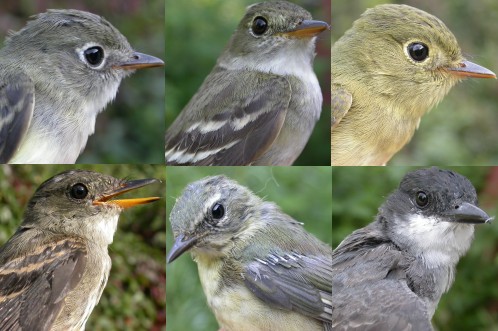
Week 4: August 22-28, 2005
|
|
| THIS WEEK | FALL TOTAL | YEAR TOTAL | SITE TOTAL | |
|---|---|---|---|---|
| # birds (and species) banded | 197 (35) | 566 (49) | 1299 (77) | 2220 (86) |
| # birds (and species) repeat | 20 (13) | 69 (18) | 314 (26) | 492 (35) |
| # birds (and species) return | 2 (2) | 7 (5) | 38 (10) | 38 (10) |
| # species observed | 72 | 100 | 146 | 161 |
| # net hours | 245.6 | 598.6 | 2253.4 | 3227.9 |
| # birds banded / net hour | 80.2 | 94.6 | 57.8 | 68.7 |
Note: table does not include nocturnal banding (owls).
Bander-in-charge: Marcel Gahbauer Assistants: Pierre Bannon, Christina Donehower, Barbara Frei, Mike Frei, Gay Gruner, Marie-Anne Hudson, Barbara MacDuff, Don MacDuff, Eve Marshall, Betsy McFarlane, Lynn Miller, Anthi Mimidakis, Julie Pepin, Vince Spinelli, Rodger Titman
Notes: There were two distinctly different phases to the past week. The first couple of days the weather was still cool, and we banded an almost overwhelming 105 birds in only 66 net hours. After that it became warmer by the day, and we caught only another 91 birds the rest of the week, despite another 180 net hours … such is the episodic nature of migration monitoring! Despite the weather-related slowdown, it was overall our busiest week ever.
Monday morning we set two new records for MBO, with 84 birds banded in a day (previously 81) and 94 birds processed including the 10 recaptures. 47 of the birds banded were warblers, with Tennessee, Nashville, Chestnut-sided, and Magnolia being the most common. We also had our first two Yellow-rumped Warblers of the fall. We expect to continue banding them well into October, so this may be a sign that the early phase of migration is coming toward its end.
Tuesday the onslaught continued – we weren’t planning to band originally, but were able to squeeze in a couple of hours and caught an additional 21 birds of 15 species during that short time.
In sharp contrast, Wednesday was by far the quietest morning we’ve experienced so far this fall. Just 19 birds banded, with no more than three of any species. Census and overall observations were similarly unimpressive.
Thursday morning we did census only, but it gave us cause for optimism. The 43 species observed was one of the highest totals of the year, and it included 13 warbler species. Among them was an unusually early Western Palm Warbler, and a Bay-breasted Warbler, only occasionally seen at MBO.
Friday and Saturday were marked principally by a mass movement of Magnolia Warblers. Prior to this week we had banded a total of 15 Magnolia Warblers; over these two days alone we had 33 (in addition to the 15 others earlier in the week). Age and sex classes can be rather confusing with this species, but with this amount of practice we’ve had a great opportunity for comparison. Though no banding took place on Sunday, they were the most common warbler seen on census. Also on Sunday, the first Red-tailed Hawk of the fall was seen, bringing the season total to 100 species already.
Saturday morning also provided the highlight of the week, month, and very possibly season – MBO’s first Blue-winged Warbler. While the species has recently expanded its range into southern Quebec, the known population remains limited to fewer than half a dozen pairs, so it seems just as likely that this bird has dispersed far north of its usual range.
Other noteworthy birds this week included late-season juveniles of Black-throated Blue Warbler, Nashville Warbler, and Blue-headed Vireo, a recapture of a Tennessee Warbler revealing a two-week stopover at MBO, and a recapture of a Song Sparrow banded here on our third day of operation last September and not seen since October 8, 200 Also of interest, a hatch-year Veery that we banded as a spotty-plumaged juvenile on July 30, and recaptured today following its first prebasic moult (see comparative photos below).
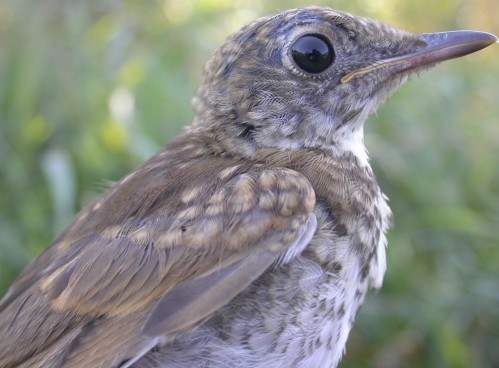 Before and after: the photos above and below are of the same Veery, taken exactly four weeks apart. On July 30 (above) it was recently out of the nest, and still showed characteristic juvenal plumage, most evident as spotting on the wings, back, and head. Since then it has undergone its first prebasic moult, such that when it was caught and photographed again on August 27 (below), it looked like an entirely different bird. (Photos by Marcel Gahbauer)
Before and after: the photos above and below are of the same Veery, taken exactly four weeks apart. On July 30 (above) it was recently out of the nest, and still showed characteristic juvenal plumage, most evident as spotting on the wings, back, and head. Since then it has undergone its first prebasic moult, such that when it was caught and photographed again on August 27 (below), it looked like an entirely different bird. (Photos by Marcel Gahbauer)
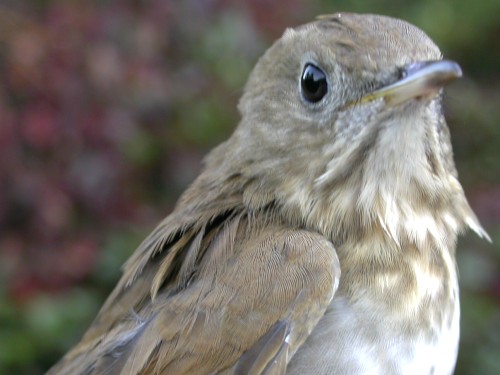
Week 5: August 29 – September 4, 2005
|
|
| THIS WEEK | FALL TOTAL | YEAR TOTAL | SITE TOTAL | |
|---|---|---|---|---|
| # birds (and species) banded | 281 (40) | 847 (53) | 1580 (78) | 2501 (88) |
| # birds (and species) repeat | 48 (13) | 117 (21) | 362 (28) | 540 (35) |
| # birds (and species) return | 8 (6) | 15 (7) | 46 (12) | 46 (12) |
| # species observed | 79 | 107 | 147 | 161 |
| # net hours | 414.9 | 1013.5 | 2668.3 | 3642.8 |
| # birds banded / net hour | 67.7 | 83.6 | 59.3 | 68.6 |
Note: table does not include nocturnal banding (owls).
Bander-in-charge: Marcel Gahbauer Assistants: Pierre Bannon, Jean Demers, Christina Donehower, Barbara Frei, Gay Gruner, Marie-Anne Hudson, Barbara MacDuff, Betsy McFarlane, Lynn Miller, Chris Murphy, Guillaume Passavy, Kristy Putnam, Crissy Ranellucci, Steven Skipper, Clémence Soulard, Vince Spinelli
Notes: This was our first week of full operation for the fall season, so it is not surprising that with six days of good weather we set a new weekly record with 283 birds banded. Wednesday was washed out with the leftover rain from Hurricane Katrina, which somewhat replenished the low water level in the ponds, but seemed to have little effect on the mix of birds present. Tuesday and Sunday the migration was quite slow, allowing us to get some much needed site maintenance done, but otherwise the level of activity was medium to high every day.
Even more than the past few, this was the week of the warblers. 19 species were banded this week, including a high of 15 on Friday. They accounted for 61% of all the birds banded this week, and up to almost 80% on a couple of days. Without exception, the most numerous species every day this week was the Magnolia Warbler, with a total of 53 banded. Though in distant second place with 27, the Red-eyed Vireo also deserves honourable mention for being unusually abundant this week.
This week we banded our first ever Philadelphia Vireo, and also added another three species to the list of birds banded this fall with Cedar Waxwing, Western Palm Warbler, and an early Slate-coloured Junco on August 29.
In addition to these, several other species were seen for the first time this season. The Connecticut Warbler on Sunday’s census was only the second ever observed at MBO. The day before, a Great Horned Owl hooted at sunrise, and the first few Canada Geese flew past overhead. Belted Kingfisher, Scarlet Tanager, and American Kestrel rounded out the week’s new additions. Overall it was the most diverse week yet this fall, with 79 species observed.
As the later migrants begin to trickle in, we’re already saying goodbye to some of the early ones. It seems that the last of the Eastern Kingbirds have already left, and the numbers of Yellow Warblers, Baltimore Orioles, Indigo Buntings, and Rose-breasted Grosbeaks have tapered off to the point that we expect them to soon disappear altogether as well. We are still seeing at least a couple of Ruby-throated Hummingbirds in the nets daily, but they too are likely to move on before long. In the meantime though we continue to enjoy their irrepressible spirit, highlighted by one on Saturday which pursued a crow over quite a long distance!
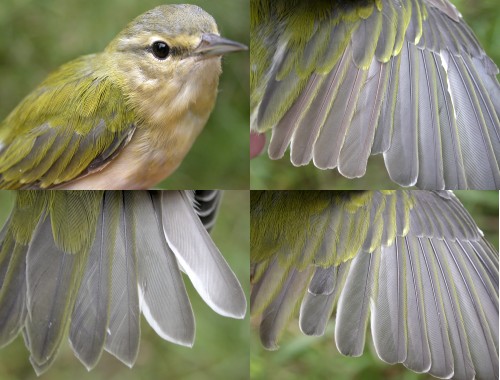 We sometimes get asked what benefit there is in looking closely at birds recaptured within a few days or weeks of when they were banded. Often little will have changed, but sometimes in fall an increase in fat and/or weight will be evident over time. Occasionally, as with the second-year male Tennessee Warbler above, we have the opportunity to document the progression of a moult. The top right photo was taken on August 22, and the bottom right photo 13 days later on September It shows that in less than two weeks, the final four juvenal secondaries (brown and worn in the top photo) have all been dropped, and are in the process of being replaced. Visible in the top right corner of both photos is the alula – a pale brown and worn juvenal feather two weeks ago, and a fresh dark feather now. Moult processes in many species remain poorly understood, so documentation of such cases can be of great value. (Photos by Marcel Gahbauer)
We sometimes get asked what benefit there is in looking closely at birds recaptured within a few days or weeks of when they were banded. Often little will have changed, but sometimes in fall an increase in fat and/or weight will be evident over time. Occasionally, as with the second-year male Tennessee Warbler above, we have the opportunity to document the progression of a moult. The top right photo was taken on August 22, and the bottom right photo 13 days later on September It shows that in less than two weeks, the final four juvenal secondaries (brown and worn in the top photo) have all been dropped, and are in the process of being replaced. Visible in the top right corner of both photos is the alula – a pale brown and worn juvenal feather two weeks ago, and a fresh dark feather now. Moult processes in many species remain poorly understood, so documentation of such cases can be of great value. (Photos by Marcel Gahbauer)
Week 6: September 5-11, 2005
|
|
| THIS WEEK | FALL TOTAL | YEAR TOTAL | SITE TOTAL | |
|---|---|---|---|---|
| # birds (and species) banded | 181 (34) | 1028 (60) | 1761 (82) | 2682 (90) |
| # birds (and species) repeat | 36 (16) | 153 (22) | 398 (29) | 576 (36) |
| # birds (and species) return | 4 (3) | 19 (7) | 50 (12) | 50 (12) |
| # species observed | 85 | 119 | 148 | 162 |
| # net hours | 459.7 | 1473.2 | 3128.0 | 4102.5 |
| # birds banded / net hour | 39.4 | 69.8 | 56.4 | 65.4 |
Note: table does not include nocturnal banding (owls).
Banders-in-charge: Marcel Gahbauer, Barbara Frei, Marie-Anne Hudson Assistants: Pierre Bannon, Martin Bowman, Mélisa Brunet, Jean Demers, Mike Frei, Gay Gruner, Isabel Julian, Barbara MacDuff, Betsy McFarlane, Anthi Mimidakis, Julia Mlynarek, Chris Murphy, Guillaume Passavy, Julie Pepin, Michelle St-Martin, Steven Skipper, David Soares, Clémence Soulard
Notes: Although it wasn’t without its highlights, week 6 was on the whole decidedly quieter than expected, given the pace of activity in recent weeks. Though we banded all seven days, we added fewer than 200 birds to the season total, and on three days couldn’t even manage to get to 20 for the morning. It seemed that the mixed warbler flocks dominated by Magnolias largely left last weekend, and the next big wave of migrants hadn’t yet arrived. Given the above-seasonal temperatures for several days this week, that’s not too surprising. Fortunately, new arrivals began trickling in on Saturday after the coldest night of the fall to date, and Sunday saw a noticeable increase in both species and individuals.
Whereas Magnolia Warbler and Red-eyed Vireo were the species which best characterized Week 5, this week it was Palm Warbler and White-throated Sparrow which dominated (setting aside the enormous flock of Common Grackles, varying daily from 260 to 750 individuals). The Palm Warbler was particularly interesting, as there are two visibly recognizable races which occur here – the Western (whitish below) with a distribution across much of the Canadian boreal forest and the Yellow (yes, yellowish below) largely restricted to Quebec. The first several Palm Warblers we observed were all Western, but then on Thursday we had our first few Yellow, and since then those have been the most frequently observed.
The Fall 2005 list of species observed grew substantially this week, with 12 new arrivals. Most notable were Broad-winged Hawk, seen migrating in good numbers on Sunday (37 birds), early Golden-crowned Kinglets and Brown Creepers, and our first ever American Pipits flying overhead. The others were Common Loon, Double-crested Cormorant, Yellow-bellied Sapsucker, Northern Rough-winged Swallow, Winter Wren, Wood Thrush, Lincoln’s Sparrow, and Rusty Blackbird.
The Fall 2005 banding list also grew nicely, with 7 additions. Monday’s Winter Wren and Sunday’s Northern Parula were firsts for MBO, bringing the cumulative list of species banded to 90. Most of this week’s other new species were also ones we have had only occasionally in the past: Sharp-shinned Hawk (3 previously), Golden-crowned Kinglet (5), Brown Creeper (6), Scarlet Tanager (2), and Common Grackle (30). Other highlights this week included recaptures of a Black-capped Chickadee and a Song Sparrow each banded during our first few days of operation last September.
Contrary to last week’s predictions, Rose-breasted Grosbeaks and Ruby-throated Hummingbirds have continued to be seen almost daily this week, although usually only one or two individuals per day. The hummingbirds have continued to entertain us, with one hovering for a while beside one of our red bird bags hanging on a branch, and another determinedly pursuing a crow. Also to our surprise, we saw a wider variety of species this week than last, with a total of 85 observed even though the most we had on any single day was 50 on Sunday.
Aside from the birds, we had a couple of other perplexing sightings this week. Several giant puffball mushrooms were spotted along the census trail, the largest of them over 40 cm in diameter. None had been seen while smaller though, indicating they must have grown very quickly, as they were in rather conspicuous locations. Even more mysterious, we found 6 dead moles (5 starnosed and 1 hairytail) and 3 dead shrews, all lying on the trails, and most of them without any visible wounds.
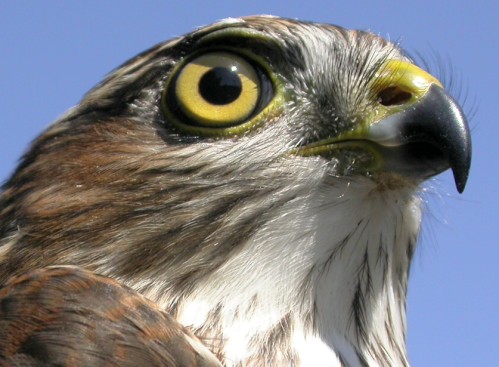 Fierce though he may look, this hatch-year Sharp-shinned Hawk banded on Tuesday was far from the largest bird banded this week. It weighed in at 94 grams, lighter than the Blue Jay we banded two days later, and much smaller (and better behaved) than the 124-gram Common Grackle we banded on Saturday. (Photo by Marcel Gahbauer)
Fierce though he may look, this hatch-year Sharp-shinned Hawk banded on Tuesday was far from the largest bird banded this week. It weighed in at 94 grams, lighter than the Blue Jay we banded two days later, and much smaller (and better behaved) than the 124-gram Common Grackle we banded on Saturday. (Photo by Marcel Gahbauer)
Week 7: September 12-18, 2005
|
|
Note: table does not include nocturnal banding (owls). Banders-in-charge: Marcel Gahbauer, Barbara Frei, Marie-Anne Hudson Assistants: Pierre Bannon, Lina Bardo, Martin Bowman, Jean Demers, Sarah Fraser, Jacinthe Gregoire, Gay Gruner, Marie-Eve Jacques, Isabel Julian, Juliana Lisi, Andreanne Lortie, Barbara MacDuff, Francine Marcoux, Mike Mayer, Betsy McFarlane, Anthi Mimidakis, Julia Mlynarek, Chris Murphy, Robert Oligny, Julie Pépin, Majorie Poirier, Limoilou-Amélie Renaud, Clémence Soulard, Kim Tendland-Frenette Quiz: Can you identify the bird below by its tail? Answer at the end of the weekly report.
Notes: What a way to make up for a quiet week 6! Last week’s total was eclipsed before Wednesday morning was finished, and by the end of Thursday we had shattered our existing record of birds banded in a week by more than 50%. With two more good mornings on Friday and Sunday, we ended up with 426 for the week, more than doubling last week’s volume. Along the way we also raised our single-day record twice, to 101 on Tuesday, and then 106 on Thursday. Surprisingly, the big rush of birds came during above seasonal temperatures, with noon temperatures approaching 30 Celsius, higher still when factoring in the humidity. Leading the way this week were six species which accounted for 53% of the birds banded: White-throated Sparrow (44), American Goldfinch (40), Nashville Warbler (38), Magnolia Warbler (37), Red-eyed Vireo (35), and Palm Warbler (32, all but one of them Yellow). The 50 species banded this week is also a one-week record for MBO, and is actually five species more than we banded in the entire 2004 fall season (though to be fair, that ran from mid-September to late October). Significant bandings this week included Grey-cheeked Thrush, Cape May Warbler, Northern Parula, and Orange-crowned Warbler (each just banded once or twice previously), and Swainson’s Thrush (13 individuals, compared to a previous total of just 8). Also of note, an unusually late Yellow Warbler on Friday. A busy week like this is only possible through the help of great volunteers. Congratulations are due to Marie-Anne and Barbara for doing a great job as new banders-in-charge during the hectic first three days of the week, and especially to their Tuesday crew of Isabel, Julie, Martin, Jean, and Clémence for helping them manage the unexpected record volume of birds. Likewise, special thanks to Marie-Eve, who carefully scribed for almost all of the birds during Thursday’s record output. While the volume of birds banded this week was more than double that of last week, the list of new species grew more slowly. Newly observed for the season were Bald Eagle (first ever for MBO), Eastern Screech-Owl, Orange-crowned Warbler, and Grey-cheeked Thrush. The latter two were among the five new species banded this week, along with Eastern Phoebe, Ruby-crowned Kinglet, and Lincoln’s Sparrow. Overall, the diversity of species observed this week was the highest yet, with a total of 90 species seen at least once, with 55 on Thursday and a near record of 62 on Sunday. Among the week’s birds were 23 species of warbler (including 18 on Sunday alone), all but three of which were banded. In all likelihood we have just experienced the peak of this fall’s migration, but we know that for many species the majority of individuals are yet to arrive, and expect to remain busy through the final six weeks of the season.
Week 8: September 19-25, 2005
|
Week 11: October 10-16, 2005
|
|
| THIS WEEK | FALL TOTAL | YEAR TOTAL | SITE TOTAL | |
|---|---|---|---|---|
| # birds (and species) banded | 185 (21) | 2874 (73) | 3607 (84) | 4528 (91) |
| # birds (and species) repeat | 24 (10) | 435 (30) | 680 (35) | 758 (41) |
| # birds (and species) return | 1 (1) | 39 (9) | 70 (14) | 70 (14) |
| # species observed | 68 | 140 | 154 | 165 |
| # net hours | 168.2 | 3255.0 | 4909.8 | 5884.3 |
| # birds banded / 100 net hours | 110.0 | 88.3 | 73.5 | 76.9 |
Note: table does not include nocturnal banding (owls).
Banders-in-charge: Marcel Gahbauer, Barbara Frei, Marie-Anne Hudson Assistants: Lina Bardo, Bianca Bourdeau, Martin Bowman, Shawn Craik, Jean Demers, Mike Frei, Gay Gruner, Annie Hibbert, Juliana Lisi, Victoria Lukasik, Barbara MacDuff, Mike Mayer, Betsy McFarlane, Chris Murphy, Julie Pepin, Clémence Soulard, Stephanie Surveyer
Notes: It was a very wet week at MBO, with net hours under half of what they typically have been this fall. However, during the sometimes brief dry spells, we managed to band a good number of birds as this year’s October migration continued in full force.
The highlight of the week was the Yellow-billed Cuckoo shown above, which we banded on Wednesday morning. In most years there are only a couple of fall records of this species in Quebec, but this year there have already been at least 15, indicating an unusually large northward post-dispersal movement beyond the cuckoo’s normal breeding range. It became our 91st species banded at MBO, and one of the most surprising, especially this late in the year.
Other species banded this week for the first time this season were Fox Sparrow and American Tree Sparrow, both arriving ‘on schedule’ with respect to their occurrence here last fall. In terms of species observed, our fall list jumped by five species this week. In addition to the three new species for the banding list, we also had our first flock of Snow Geese on Monday, and a Green-winged Teal was on the pond near net G1 on Saturday. (Note: reviewing the season list this week, we realized that two earlier additions — Greater Yellowlegs on Oct 5 and Savannah Sparrow on Sept 28 — got missed as newcomers, and thus the total for fall has been increased to 140).
Overall, species diversity is declining noticeably as we move toward the late part of the fall migration, with the number observed this week declining to 68. Nonetheless, we still had daily totals in the low 40s on four days, which is quite impressive for this time of year. New late season dates for species this week include Rose-breasted Grosbeak (Oct 11), Wood Thrush (Oct 13), and Gray Catbird (Oct 15).
The top five species banded this week represent a dramatic shift from recent weeks. American Robins have suddenly arrived in tremendous numbers, with between 180 and 500 observed daily, and 34 banded despite our rain-limited net operations. On the other hand, the White-throated Sparrows which have been so dominant over the previous month largely departed, falling to sixth place among banded birds this week with 10. The remainder of the top five were Slate-coloured Junco (32), Ruby-crowned Kinglet (26), Black-capped Chickadee (16), and Yellow-rumped Warbler (12).
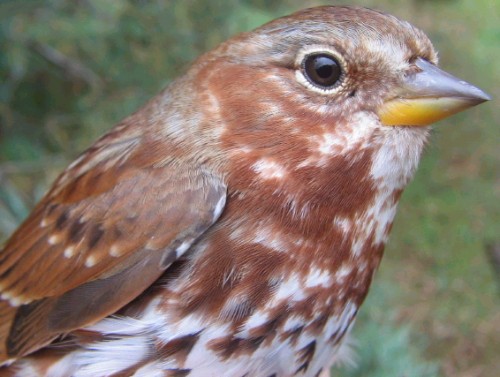 Fox Sparrows are an uncommon but regular late season migrant at MBO. This individual banded on Saturday was the first one caught this fall. (Photo by Marie-Anne Hudson)
Fox Sparrows are an uncommon but regular late season migrant at MBO. This individual banded on Saturday was the first one caught this fall. (Photo by Marie-Anne Hudson)
Week 12: October 17-23, 2005
|
|
| THIS WEEK | FALL TOTAL | YEAR TOTAL | SITE TOTAL | |
|---|---|---|---|---|
| # birds (and species) banded | 157 (17) | 3031 (75) | 3764 (84) | 4685 (92) |
| # birds (and species) repeat | 14 (7) | 449 (31) | 694 (36) | 772 (41) |
| # birds (and species) return | 0 (0) | 39 (9) | 70 (14) | 70 (14) |
| # species observed | 57 | 146 | 160 | 167 |
| # net hours | 190.2 | 3445.2 | 5100.0 | 6074.5 |
| # birds banded / 100 net hours | 82.5 | 88.0 | 73.9 | 77.1 |
Note: table does not include nocturnal banding (owls).
Banders-in-charge: Marcel Gahbauer, Barbara Frei Assistants: Lina Bardo, Bianca Bourdeau, Martin Bowman, Averill Craig, Shawn Craik, Jean Demers, Gay Gruner, Bana Hamze, Marylise Lefevre, Juliana Lisi, Andreanne Lortie, Barbara MacDuff, Don MacDuff, Francine Marcoux, Mike Mayer, Betsy McFarlane, Chris Murphy, Julie Pépin, Stephanie Surveyer, Kim Tendland-Frenette
Notes: Again this week the wet weather was a serious limiting factor, with full banding possible only on Friday and Saturday. Nonetheless, both banding and general observations yielded interesting results almost daily.
Though we are approaching the end of the season, the fall list of species banded this season grew again this week. The White-breasted Nuthatch (photo at the end of this week’s report) was long overdue, having been observed at least a few times each week since we began observations at the beginning of August. The other species, however, was another complete surprise. Unlike last week’s Yellow-billed Cuckoo, remarkable for being out of its normal range, this week’s Red-shouldered Hawk shocked us by being by far the largest bird we’ve caught to date. Weighing in at 531 grams, it was nearly twice as heavy as our previous record holder, last fall’s Pileated Woodpecker. However, it was an incredibly patient and docile bird, taking the whole experience nicely in stride and not once attempting to bite or grab any of us.
Census and other observations yielded several more new species for the season this week. The highlight was a Boreal Chickadee seen near the winter nets late on Thursday morning. This species is only rarely recorded in Montreal, but with the large number of Black-capped Chickadees migrating this fall, it appears that a few Boreal are moving with them (one has been seen as far south as Lake Erie). Another unexpected northern migrant was the Bohemian Waxwing discovered on Sunday’s census. The first census of the week also held an impressive discovery, an adult Peregrine Falcon perched in one of the trees along the back pond. Later in the week we had our first Pine Siskins of the fall fly overhead, a tiny Cackling Goose dwarfed by the Canada Geese with which it was flying, and a flock of Northern Pintails.
The dominant birds at MBO this week were without question American Robin, Slate-coloured Junco, and Red-winged Blackbird. The blackbirds were in full song some mornings, creating an absolute cacophony of sound. Up to 500 robins were seen per day, though their numbers dropped sharply late in the week. Though not as abundant as that, the 50 to 70 Mourning Doves seen on a couple of days represented unusually high numbers for the area.
For the second week in a row, American Robin took the top spot with 47 individuals banded. With a single-day record of 27 on Friday, Black-capped Chickadee made it to second place for the week with 37. The remainder of the top five were Slate-coloured Junco (22), American Tree Sparrow (10), and American Goldfinch (9, all on Saturday). Our 3000th bird banded of the season was a hatch-year Hermit Thrush early on Saturday morning.
Not surprisingly, the number of species observed this week dropped again, and for the first time this fall included no warblers at all, and just one vireo, a Blue-headed which perched just outside the window as we were recording daily totals on Thursday. The two Gray Catbirds seen on Sunday established a new record late date for this species at MBO. As we move into our final week of the fall season, we expect the transition to the winter bird community to continue.
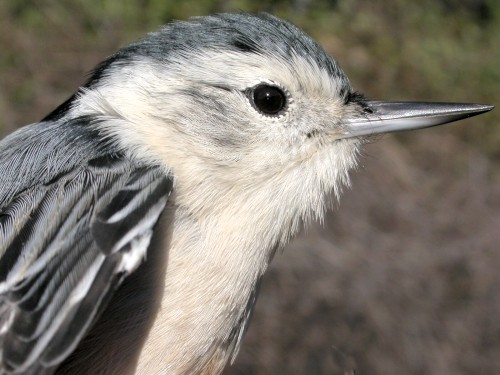 Though fairly regularly seen at MBO, White-breasted Nuthatches are seldom caught in the mist nets. This after-hatch-year female banded on Friday was only the second one banded this year, and the first of the fall. (Photo by Marcel Gahbauer)
Though fairly regularly seen at MBO, White-breasted Nuthatches are seldom caught in the mist nets. This after-hatch-year female banded on Friday was only the second one banded this year, and the first of the fall. (Photo by Marcel Gahbauer)
Week 13: October 24-30, 2005
|
|
| THIS WEEK | FALL TOTAL | YEAR TOTAL | SITE TOTAL | |
|---|---|---|---|---|
| # birds (and species) banded | 195 (20) | 3226 (78) | 3959 (84) | 4880 (92) |
| # birds (and species) repeat | 47 (9) | 496 (33) | 741 (36) | 819 (41) |
| # birds (and species) return | 2 (2) | 41 (10) | 72 (14) | 72 (14) |
| # species observed | 54 | 151 | 162 | 168 |
| # net hours | 281.1 | 3726.3 | 5381.1 | 6355.6 |
| # birds banded / 100 net hours | 69.4 | 86.6 | 73.6 | 76.8 |
Note: table does not include nocturnal banding (owls).
Banders-in-charge: Marcel Gahbauer, Barbara Frei, Marie-Anne Hudson Assistants: Pierre Bannon, Jean Beaudreault, Elise Bolduc, Bianca Bourdeau, Martin Bowman, Shawn Craik, Christina Donehower, Lena Douris, Sarah Fraser, Gay Gruner, Keelan Jacobs, Andreanne Lortie, Barbara MacDuff, Don MacDuff, Francine Marcoux, Mike Mayer, Betsy McFarlane, Anthi Mimidakis, Frederic Paquet, Julie Pépin, Crissy Ranellucci, Natacha Raymond-Bleau
Notes: Our thirteenth and final week of the 2005 Fall Migration Monitoring Program has come to an end. Sincere thanks to all who have helped out since the beginning of August, especially the “regulars” who have been out once or more per week. On the whole we’ve had a tremendously successful fall season, but it would not have been possible without all this help.
The October rainy season continued into this week, but at last by Thursday the skies dried up, and over our final weekend we had glorious sunshine. As a result, we actually banded a few more birds than in week 12, and the decline in number of species observed compared to last week was only a small one.
As expected though, the bird community has taken on a decidedly wintry feel in this final week. Not a single warbler was observed and just one vireo (a Blue-headed on Monday) was seen, and there were only a few other late-lingering birds: Gray Catbird (Monday), Chipping Sparrow (Friday), and Ruby-crowned Kinglet (Sunday). On the other hand, the “winter finches” were well represented with Purple Finch, Pine Siskin, Common Redpoll, Pine Grosbeak, and Snow Bunting arriving in small numbers (the final three species all new additions to the fall list). The Northern Shrike which arrived on Monday was also a first for the season, and the several flocks totaling 1180 scaup on Thursday were entirely new for MBO (likely they included both Lesser and Greater Scaup, but the only ones we had a chance to look at closely were all Lesser). The flock of 34 Snow Buntings on our final day brought the season total to 151 species, many more than we had expected.
Slate-coloured Juncos dominated this week in the nets, with 79 individuals, representing over 40% of all birds banded. Far behind in second place were Black-capped Chickadees with 31, but there seemed like many more due to the 30 recaptures we had during the week. A surprise newcomer to the top 5 was Fox Sparrow with 20 – last year we banded only one for the whole fall season, and prior to this week our cumulative total was only 15! Rounding out the final week’s top 5 were American Robin (18) and American Tree Sparrow (16).
Meanwhile, a couple more nights of owling brought our season total of Northern Saw-whet Owls up to 17, the same as in 200 While the fall season for passerines has come to a close, we may yet try for owls a few more nights, if weather conditions are suitable.
A full report on the 2005 Fall Migration Monitoring Program will be prepared by mid-December, and will be posted on the MBO Banding Log page. Banding will continue during the winter, but at a reduced frequency; the website updates will likely continue on a weekly basis.
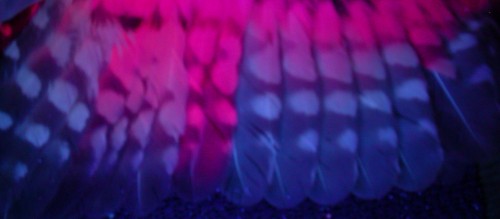 The underwing of a Northern Saw-whet Owl, as viewed under ultraviolet light. Doing so allows for easy discrimination among the ages of primaries and secondaries. For example in the photo above there are three generations of feathers visible: new (grown this summer/fall) in the centre, fluorescing bright pink; four one-year-old feathers to their left with an intermediate amount of pink; two-year-old feathers throughout the rest of the wing, with only a bit of pink showing. This allows us to determine that the bird is at least in its third year, i.e. after-second-year. (Photo by Marcel Gahbauer)
The underwing of a Northern Saw-whet Owl, as viewed under ultraviolet light. Doing so allows for easy discrimination among the ages of primaries and secondaries. For example in the photo above there are three generations of feathers visible: new (grown this summer/fall) in the centre, fluorescing bright pink; four one-year-old feathers to their left with an intermediate amount of pink; two-year-old feathers throughout the rest of the wing, with only a bit of pink showing. This allows us to determine that the bird is at least in its third year, i.e. after-second-year. (Photo by Marcel Gahbauer)
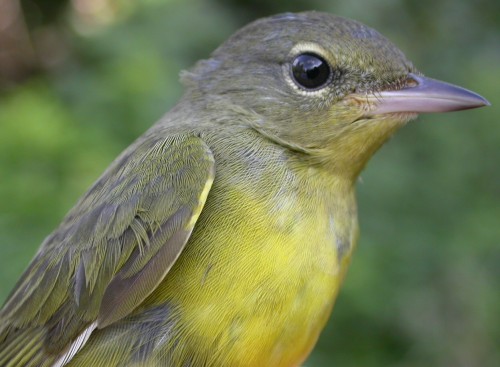 Despite the many warbler species banded last week, there were some we missed. One of these was Mourning Warbler, a species which we caught for the first time ever this week. The photo above is of a hatch-year Mourning Warbler, sex unknown. (Photo by Marcel Gahbauer)
Despite the many warbler species banded last week, there were some we missed. One of these was Mourning Warbler, a species which we caught for the first time ever this week. The photo above is of a hatch-year Mourning Warbler, sex unknown. (Photo by Marcel Gahbauer)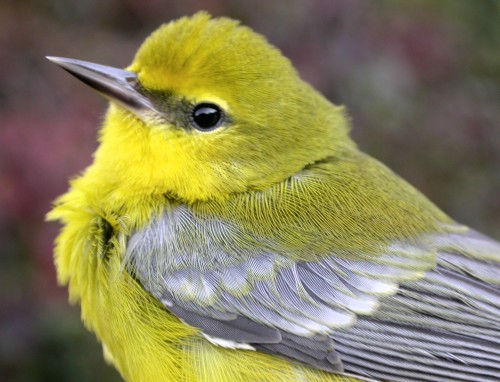 This hatch-year female Blue-winged Warbler is arguably the most unexpected bird banded to date at MBO. With only a very small breeding population known in southern Quebec, this bird may well have traveled at least a few hundred kilometres east from Ontario or north from the United States to reach us here – a reminder that migration is not necessarily as linear and directional as is commonly believed. (Photo by Marcel Gahbauer)
This hatch-year female Blue-winged Warbler is arguably the most unexpected bird banded to date at MBO. With only a very small breeding population known in southern Quebec, this bird may well have traveled at least a few hundred kilometres east from Ontario or north from the United States to reach us here – a reminder that migration is not necessarily as linear and directional as is commonly believed. (Photo by Marcel Gahbauer)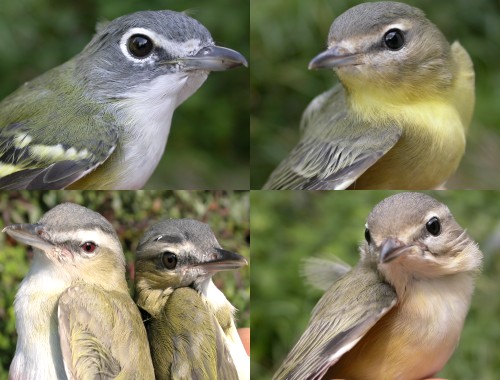 This week brought MBO far more vireos than ever before. By far the most numerous were the Red-eyed Vireos, shown at bottom left with an after-hatch-year male on the left and a hatch-year sex unknown on the right. On Friday, net G2 contained not only a Red-eyed Vireo, but also the week’s only Blue-headed Vireo (top left) and one of two Philadelphia Vireos (top right). As for the bird at bottom right … it too is a Philadelphia Vireo, although much less distinctly marked than the other. (Photos by Marcel Gahbauer)
This week brought MBO far more vireos than ever before. By far the most numerous were the Red-eyed Vireos, shown at bottom left with an after-hatch-year male on the left and a hatch-year sex unknown on the right. On Friday, net G2 contained not only a Red-eyed Vireo, but also the week’s only Blue-headed Vireo (top left) and one of two Philadelphia Vireos (top right). As for the bird at bottom right … it too is a Philadelphia Vireo, although much less distinctly marked than the other. (Photos by Marcel Gahbauer) This hatch-year female Northern Parula became the 24th warbler species banded at MBO, and the 60th species banded since the beginning of August. (Photo by Marcel Gahbauer)
This hatch-year female Northern Parula became the 24th warbler species banded at MBO, and the 60th species banded since the beginning of August. (Photo by Marcel Gahbauer)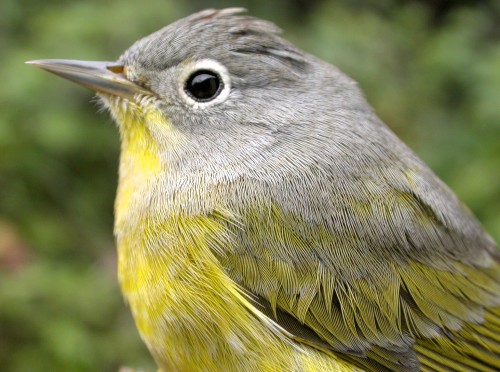 This week Nashville Warbler took over from Magnolia as the most abundant warbler banded. Most of the Nashville Warblers passing through now are hatch-year birds, but there are still occasional adults, such as the male shown above. Overall it was a great week for warblers, with 23 species observed and 20 banded, with as many as 16 species caught on some days. (Photo by Marcel Gahbauer)
This week Nashville Warbler took over from Magnolia as the most abundant warbler banded. Most of the Nashville Warblers passing through now are hatch-year birds, but there are still occasional adults, such as the male shown above. Overall it was a great week for warblers, with 23 species observed and 20 banded, with as many as 16 species caught on some days. (Photo by Marcel Gahbauer)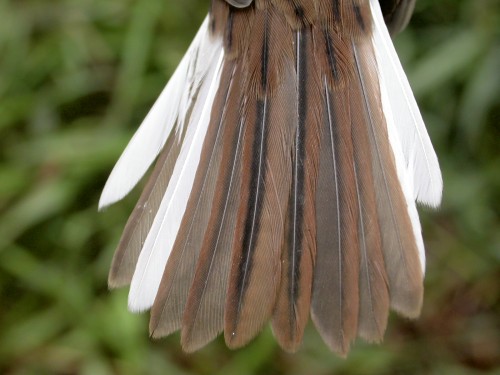
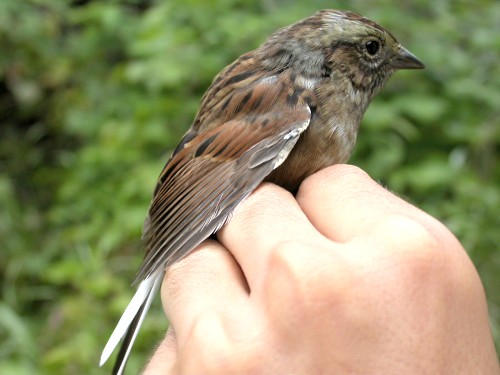 Quiz answer: it is a Swamp Sparrow! The white tail feathers are reminiscent of a Slate- coloured Junco, a species which is known to have hybridized with various other sparrow species. However, there are no documented records of Swamp Sparrows interbreeding with any other species, and in all other respects this bird looks like a typical Swamp Sparrow. One of the many mysteries uncovered in the process of banding! (Photo by Marcel Gahbauer)
Quiz answer: it is a Swamp Sparrow! The white tail feathers are reminiscent of a Slate- coloured Junco, a species which is known to have hybridized with various other sparrow species. However, there are no documented records of Swamp Sparrows interbreeding with any other species, and in all other respects this bird looks like a typical Swamp Sparrow. One of the many mysteries uncovered in the process of banding! (Photo by Marcel Gahbauer)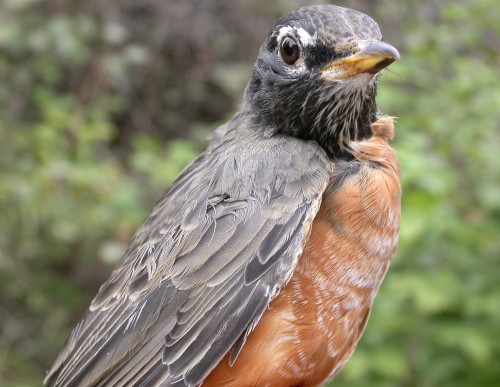 On September 24, 1905, James Henry Fleming banded an American Robin in his Toronto backyard, marking the start of banding in Canada. Exactly one century later, we banded this American Robin at MBO. Over the past 100 years, the North American banding program has greatly advanced our understanding of migration, dispersal, longevity, habitat selection, social structure, and various aspects of ecology through the banding of over 66 million birds. Yet the American Robin is an appropriate bird with which to celebrate this anniversary, as there are still many questions to be answered about even a common bird such as this. We hope that McGill Bird Observatory will continue to contribute to this ever-growing body of knowledge for many years to come. (Photo by Marcel Gahbauer)
On September 24, 1905, James Henry Fleming banded an American Robin in his Toronto backyard, marking the start of banding in Canada. Exactly one century later, we banded this American Robin at MBO. Over the past 100 years, the North American banding program has greatly advanced our understanding of migration, dispersal, longevity, habitat selection, social structure, and various aspects of ecology through the banding of over 66 million birds. Yet the American Robin is an appropriate bird with which to celebrate this anniversary, as there are still many questions to be answered about even a common bird such as this. We hope that McGill Bird Observatory will continue to contribute to this ever-growing body of knowledge for many years to come. (Photo by Marcel Gahbauer)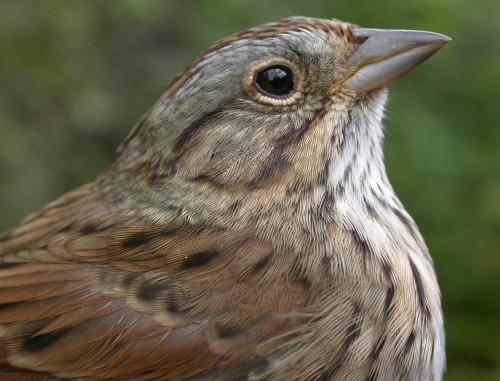 As we move into late September, sparrows are taking over from warblers as the dominant birds in the nets, as well as in terms of overall numbers on the site. White-throated and Song Sparrows are by far the most abundant, but this week we also banded five other species, including this Lincoln’s Sparrow. (Photo by Marcel Gahbauer)
As we move into late September, sparrows are taking over from warblers as the dominant birds in the nets, as well as in terms of overall numbers on the site. White-throated and Song Sparrows are by far the most abundant, but this week we also banded five other species, including this Lincoln’s Sparrow. (Photo by Marcel Gahbauer)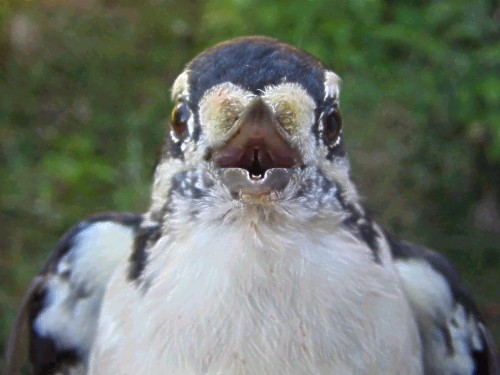 This female Downy Woodpecker banded on Wednesday morning was the 2000th bird of the fall season. August and September have surpassed all expectations, and we hope that our good fortunes will continue through to the end of October. (Photo by Marie-Anne Hudson)
This female Downy Woodpecker banded on Wednesday morning was the 2000th bird of the fall season. August and September have surpassed all expectations, and we hope that our good fortunes will continue through to the end of October. (Photo by Marie-Anne Hudson)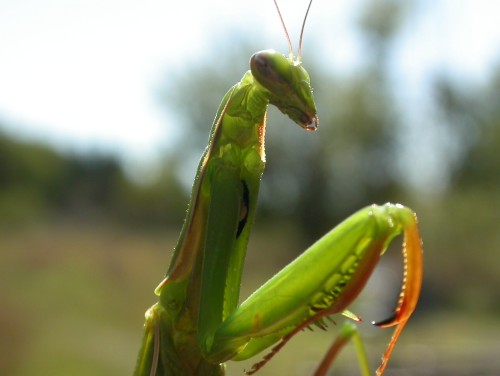 Even though the calendar has turned to October, a wide variety of insect life remains active at MBO. To our chagrin, this includes a healthy population of mosquitoes, wasps, and bees. However, we have also observed a variety of more welcome visitors, including Monarch and Common Sulphur butterflies, a variety of grasshoppers, and a couple of praying mantises, one of which is pictured above. (Photo by Marcel Gahbauer)
Even though the calendar has turned to October, a wide variety of insect life remains active at MBO. To our chagrin, this includes a healthy population of mosquitoes, wasps, and bees. However, we have also observed a variety of more welcome visitors, including Monarch and Common Sulphur butterflies, a variety of grasshoppers, and a couple of praying mantises, one of which is pictured above. (Photo by Marcel Gahbauer)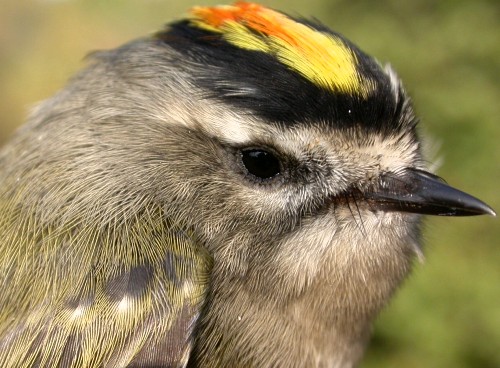 This was the week of the kinglets at MBO, culminating in a crazy Sunday on which over 200 individuals were caught in just 27 net hours. This male Golden-crowned Kinglet was photographed on a quieter day earlier in the week. (Photo by Marcel Gahbauer)
This was the week of the kinglets at MBO, culminating in a crazy Sunday on which over 200 individuals were caught in just 27 net hours. This male Golden-crowned Kinglet was photographed on a quieter day earlier in the week. (Photo by Marcel Gahbauer)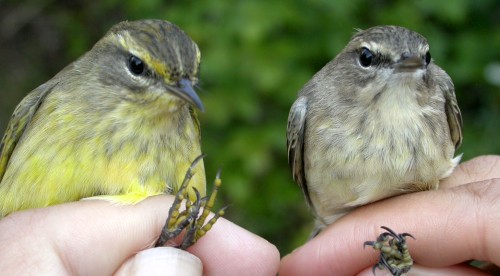
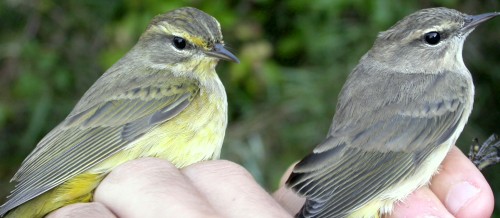 Answer: the bird on the left is a Palm Warbler, and the bird on the right is a … Palm Warbler! These two hatch-year birds banded on October 5 illustrate the two extremes of colouration found in fall Palm Warblers. The bird on the left is distinctly a Yellow Palm Warbler (Dendroica palmarum hypochrysea), while the one on the right is clearly a Western Palm Warbler (Dendroica palmarum palmarum). Unfortunately many individuals show an intermediate colouration and are more difficult to accurately assess to the level of subspecies. (Photos by Marcel Gahbauer)
Answer: the bird on the left is a Palm Warbler, and the bird on the right is a … Palm Warbler! These two hatch-year birds banded on October 5 illustrate the two extremes of colouration found in fall Palm Warblers. The bird on the left is distinctly a Yellow Palm Warbler (Dendroica palmarum hypochrysea), while the one on the right is clearly a Western Palm Warbler (Dendroica palmarum palmarum). Unfortunately many individuals show an intermediate colouration and are more difficult to accurately assess to the level of subspecies. (Photos by Marcel Gahbauer)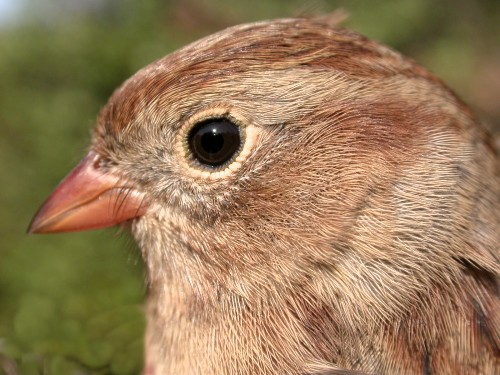 Bonus photo: The rarest bird banded at MBO during week 10 was this Field Sparrow, only the third in the history of the station. (Photo by Marcel Gahbauer)
Bonus photo: The rarest bird banded at MBO during week 10 was this Field Sparrow, only the third in the history of the station. (Photo by Marcel Gahbauer)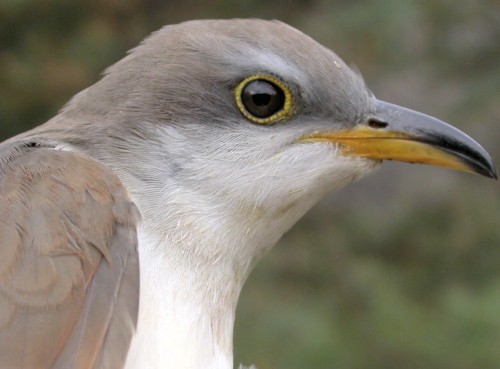 This hatch-year Yellow-billed Cuckoo was a surprise addition to the fall banding list this week. While a Yellow-billed Cuckoo was heard at MBO in late May and early June, this was the first sighting of the species here (Photo by Marcel Gahbauer)
This hatch-year Yellow-billed Cuckoo was a surprise addition to the fall banding list this week. While a Yellow-billed Cuckoo was heard at MBO in late May and early June, this was the first sighting of the species here (Photo by Marcel Gahbauer)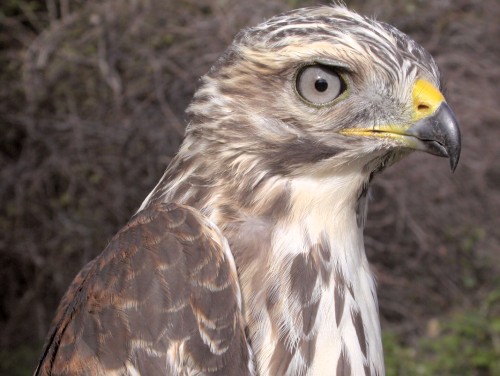 This hatch-year Red-shouldered Hawk was waiting for us in net E1 at closing time on Thursday. Though much larger than any other bird we have handled at MBO, it was remarkably well behaved and did not give us any trouble at all. A pair of Red-shouldered Hawks nested in the adjacent Morgan Arboretum this summer, and this may be one of their offspring; however, Thursday was also a great day for raptor migration and this could have been an individual from elsewhere just passing through. (Photo by Marcel Gahbauer)
This hatch-year Red-shouldered Hawk was waiting for us in net E1 at closing time on Thursday. Though much larger than any other bird we have handled at MBO, it was remarkably well behaved and did not give us any trouble at all. A pair of Red-shouldered Hawks nested in the adjacent Morgan Arboretum this summer, and this may be one of their offspring; however, Thursday was also a great day for raptor migration and this could have been an individual from elsewhere just passing through. (Photo by Marcel Gahbauer)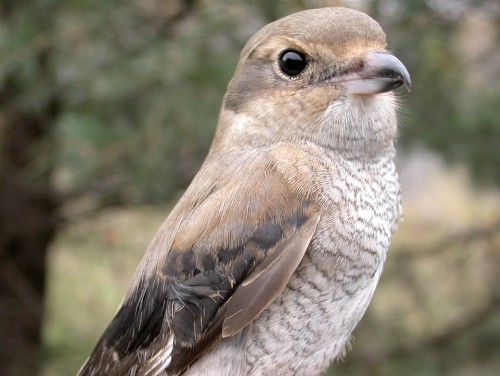 The hatch-year Northern Shrike above was the only one banded during this year’s Fall Migration Monitoring Program, and became the 78th species banded of the season. (Photo by Marcel Gahbauer)
The hatch-year Northern Shrike above was the only one banded during this year’s Fall Migration Monitoring Program, and became the 78th species banded of the season. (Photo by Marcel Gahbauer)